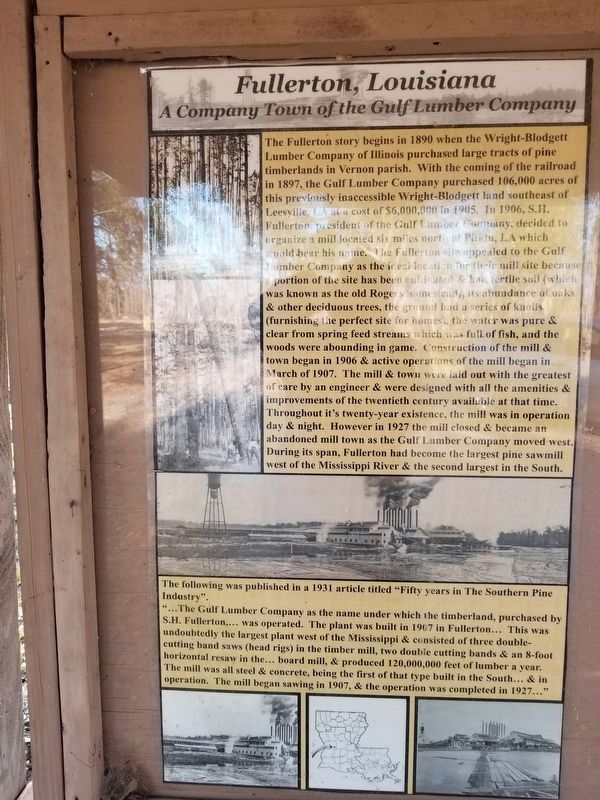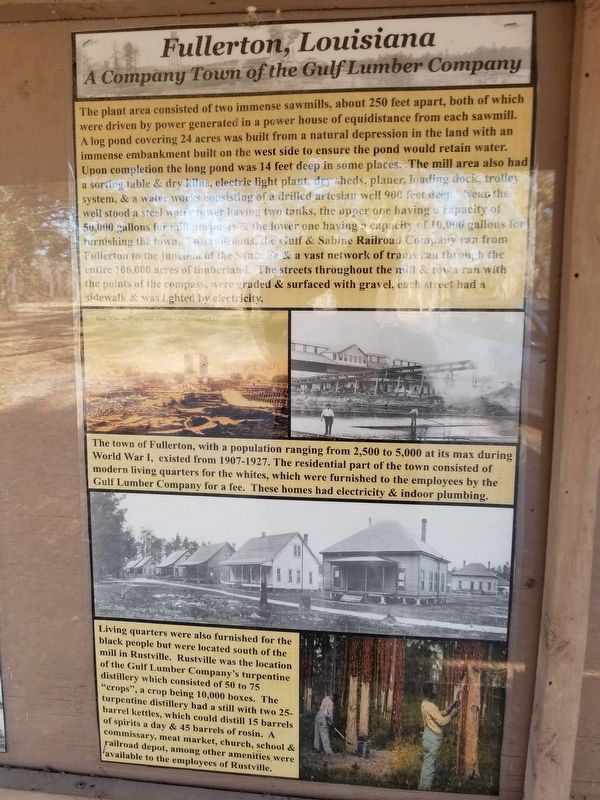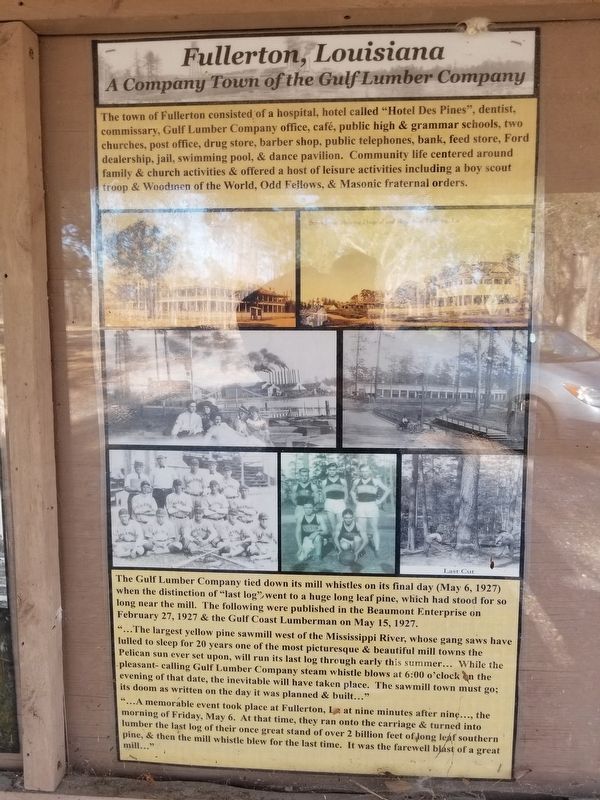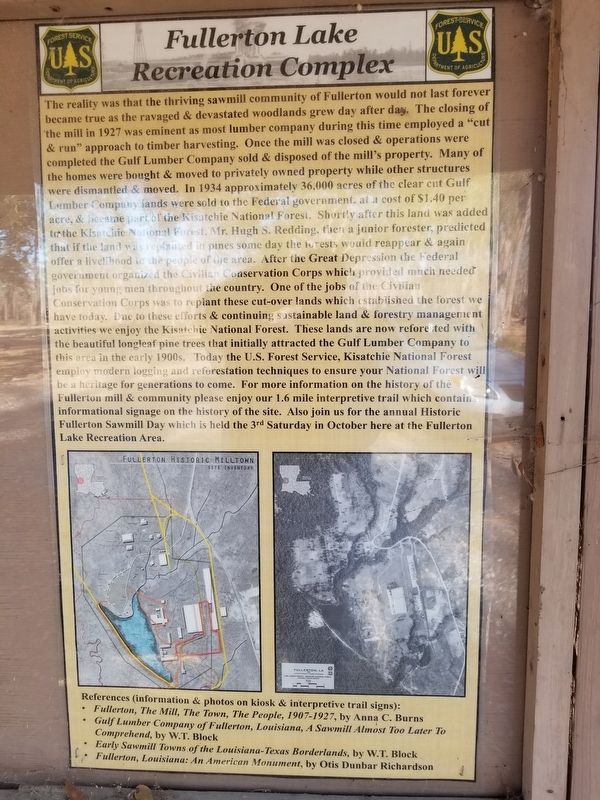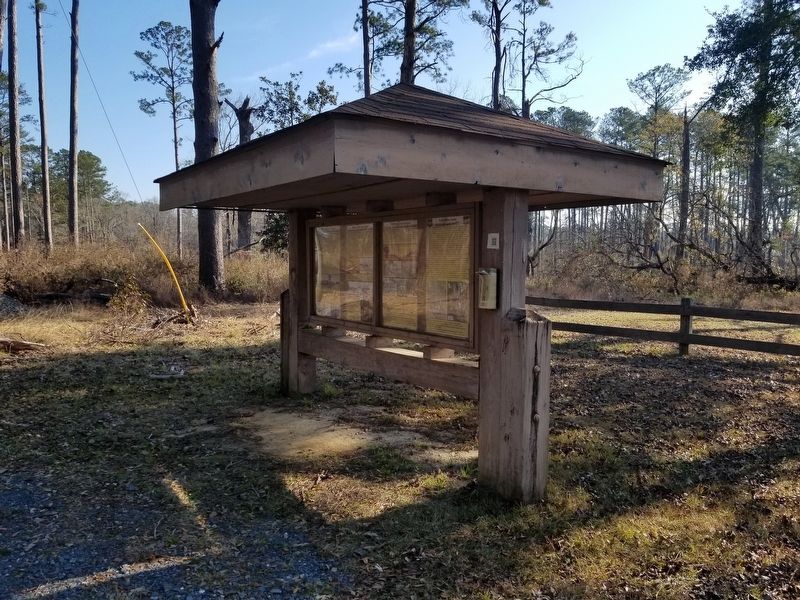Fullerton in Vernon Parish, Louisiana — The American South (West South Central)
Fullerton, Louisiana
A Company Town of the Gulf Lumber Company
— Fullerton Lake Recreation Complex —
Panel 1
The Fullerton story begins in 1890 when the Wright-Blodgett Lumber Company of Illinois purchased large tracts of pine timberlands in Vernon parish. With the coming of the railroad in 1897, the Gulf Lumber Company purchased 106,000 acres of this previously inaccessible Wright-Blodgett land southeast of Leesville, LA at a cost of $6,000,000 in 1905. In 1906, S.H. Fullerton president of the Gulf Lumber Company, decided to organize a mill located six miles north of Pitkin, LA which would bear his name. The Fullerton site appealed to the Gulf Lumber Company as the ideal location for the mill site because a portion of the site has been cultivated & had fertile soil (which was known as the old Rogers Homestead), its abundance of oaks & other deciduous trees, the ground had a series of knolls- (furnishing the perfect site for homes), the water was pure & clear from spring feed streams which was full of fish, and the woods were abounding in game. Construction of the mill & town began in 1906 & active operations of the mill began in March of 1907. The mill & town were laid out with the greatest of care by an engineer & were designed with all the amenities & improvements of the twentieth century available at that time. Throughout it's twenty-year existence, the mill was in operation day & night. However in 1927 the mill closed & became an abandoned mill town as the Gulf Lumber Company moved west. During its span, Fullerton had become the largest pine sawmill west of the Mississippi River & the second largest in the South.
The following was published in a 1931 article titled “Fifty years in The Southern Pine Industry". “... The Gulf Lumber Company as the name under which he timberland, purchased by S.H. Fullerton,... was operated. The plant was built in 1907 in Fullerton... This was undoubtedly the largest plant west of the Mississippi & consisted of three double- cutting band saws (head rigs) in the timber mill, two double cutting bands & an 8-foot horizontal resaw in the... board mill, & produced 120,000,000 feet of lumber a year. The mill was all steel & concrete, being the first of that type built in the South... & in operation. The mill began sawing in 1907, & the operation was completed in 1927...”
Panel 2
The plant area consisted of two immense sawmills, about 250 feet apart, both of which were driven by power generated in a power house of equidistance from each sawmill. A log pond covering 24 acres was built from a natural depression in the land with an immense embankment built on the west side to ensure the pond would retain water. Upon completion the long pond was 14 feet deep in some places. The mill area also had a sorting table & dry kilns, electric light plant, dry sheds, planer, loading dock, trolley system, & a water works consisting of a drilled artesian well 900 feet deep. Near the well stood a steel water tower having two tanks, the upper one having a capacity of 50,000 gallons for all purposes & the lower one having a capacity of 10,000 gallons for furnishing the town. Two railroads, the Gulf & Sabine Railroad Company ran from Fullerton to the junction of the Santa Fe & a vast network of trams ran through the entire 106,000 acres of timberland. The streets throughout the mill & town ran with the points of the compass, were graded & surfaced with gravel, each street had a sidewalk & was lighted by electricity.
The town of Fullerton, with a population ranging from 2,500 to 5,000 at its max during World War I, existed from 1907-1927. The residential part of the town consisted of modern living quarters for the whites, which were furnished to the employees by the Gulf Lumber Company for a fee. These homes had electricity & indoor plumbing.
Living quarters were also furnished for the black people but were located south of the mill in Rustville. Rustville was the location of the Gulf Lumber Company's turpentine distillery which consisted of 50 to 75 “crops”, a crop being 10,000 boxes. The turpentine distillery had a still with two 25- barrel kettles, which could distill 15 barrels of spirits a day & 45 barrels of rosin. A commissary, meat market, church, school & railroad depot, among other amenities were available to the employees of Rustville.
Panel 3
The town of Fullerton consisted of a hospital, hotel called "Hotel Des Pines”, dentist, commissary, Gulf Lumber Company office, café, public high & grammar schools, two churches, post office, drug store, barber shop, public telephones, bank, feed store, Ford dealership, jail, swimming pool, & dance pavilion. Community life centered around family & church activities & offered a host of leisure activities including a boy scout troop & Woodmen of the World, Odd Fellows, & Masonic fraternal orders.
The Gulf Lumber Company tied down its mill whistles on its final day (May 6, 1927) when the distinction of "last log", went to a huge long leaf pine, which had stood for so long near the mill. The following were published in the Beaumont Enterprise on February 27, 1927 & the Gulf Coast Lumberman on May 15, 1927. “...The largest yellow pine sawmill west of the Mississippi River, whose gang saws have lulled to sleep for 20 years one of the most picturesque & beautiful mill towns the Pelican sun ever set upon, will run its last log through early this summer... While the pleasant- calling Gulf Lumber Company steam whistle blows at 6:00 o'clock in the evening of that date, the inevitable will have taken place. The sawmill town must go; its doom as written on the day it was planned & built..."
“...A memorable event took place at Fullerton, In at nine minutes after nine..., the morning of Friday, May 6. At that time, they ran onto the carriage & turned into lumber the last log of their once great stand of over 2 billion feet of long leaf southern pine, & then the mill whistle blew for the last time. It was the farewell blast of a great mill..."
Panel 4
The reality was that the thriving sawmill community of Fullerton would not last forever became true as the ravaged & devastated woodlands grew day after day. The closing of the mill in 1927 was eminent as most lumber company during this time employed a "cut & run” approach to timber harvesting. Once the mill was closed & operations were completed the Gulf Lumber Company sold & disposed of the mill's property. Many of the homes were bought & moved to privately owned property while other structures were dismantled & moved. In 1934 approximately 36,000 acres of the clear cut Gulf Limber Company lands were sold to the Federal government, at a cost of $1.40 per acre, & became part of the Kisatchie National Forest. Shortly after this land was added to the Kisatchie National Forest, Mr. Hugh S. Redding, then a junior forester, predicted that if the land was replanted in pines some day the forests would reappear & again offer a livelihood to the people of the area. After the Great Depression the Federal government organized the Civilian Conservation Corps which provided much needed jobs for young men throughout the country. One of the jobs of the Civilian Conservation Corps was to replant these cut-over lands which established the forest we have today. Due to these efforts & continuing sustainable land & forestry management activities we enjoy the Kisatehie National Forest. These lands are now refore ted with the beautiful longleaf pine trees that initially attracted the Gulf Lumber Company to this area in the early 1900s. Today the U.S. Forest Service, Kisatchie National Forest employ modern logging and reforestation techniques to ensure your National Forest will be a heritage for generations to come. For more information on the history of the Fullerton mill & community please enjoy our 1.6 mile interpretive trail which contains informational signage on the history of the site. Also join us for the annual Historic Fullerton Sawmill Day which is held the 3rd Saturday in October here at the Fullerton Lake Recreation Area.
References (information & photos on kiosk & interpretive trail signs):
•Fullerton, The Mill, The Town, The People, 1907-1927, by Anna C. Burns
•Gulf Lumber Company of Fullerton, Louisiana, A Sawmill Almost Too Later To Comprehend, by W.T. Block
•Early Sawmill Towns of the Louisiana-Texas Borderlands, by W.T. Block.
•Fullerton, Louisiana: An American Monument, by Otis Dunbar Richardson
Erected by USDA Forestry Division.
Topics. This historical marker is listed in these topic lists: Industry & Commerce • Parks & Recreational Areas • Settlements & Settlers. A significant historical date for this entry is May 6, 1927.
Location. 31° 0.655′ N, 92° 59.177′ W. Marker is in Fullerton, Louisiana, in Vernon Parish. Marker is on Fullerton Lake Road, 0.8 miles south of State Highway 399, on the left when traveling south. Touch for map. Marker is in this post office area: Pitkin LA 70656, United States of America. Touch for directions.
Other nearby markers. At least 8 other markers are within 9 miles of this marker, measured as the crow flies. Fullerton Mill & Town (within shouting distance of this marker); Fullerton Pavilion (within shouting distance of this marker); Sawmills & Electric Plant (about 300 feet away, measured in a direct line); Elementary and High School (approx. ¼ mile away); Public Swimming Pool and Hospital (approx. 0.3 miles away); Religion in the Neutral Strip (approx. 6.1 miles away); a different marker also named Fullerton (approx. 8.7 miles away); Old Confederate Military Road (approx. 8.9 miles away). Touch for a list and map of all markers in Fullerton.
Credits. This page was last revised on January 30, 2022. It was originally submitted on January 30, 2022, by Cajun Scrambler of Assumption, Louisiana. This page has been viewed 235 times since then and 26 times this year. Photos: 1, 2, 3, 4, 5. submitted on January 30, 2022, by Cajun Scrambler of Assumption, Louisiana.
